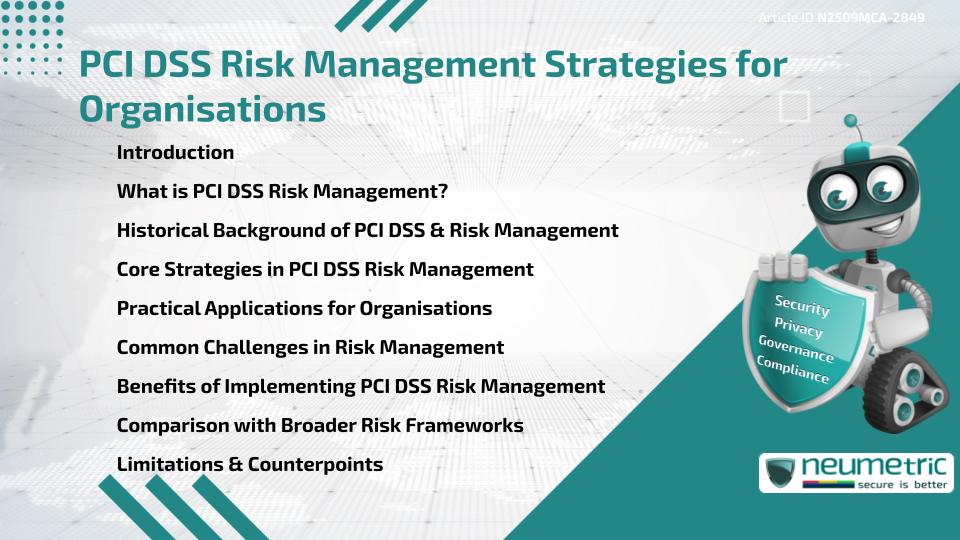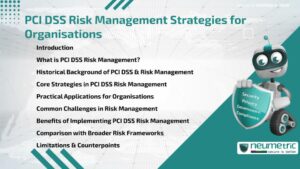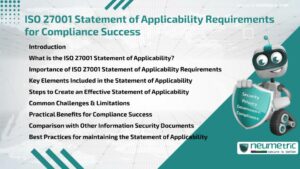Table of Contents
ToggleIntroduction
The PCI DSS Risk Management process is essential for Organisations that handle Cardholder Data. It combines Security Controls with structured Risk Assessment practices to minimise Threats & achieve compliance with the Payment Card Industry Data Security Standard [PCI DSS]. By following PCI DSS Risk Management strategies, businesses can protect Sensitive Information, reduce Financial Risks & maintain Customer Trust. These strategies apply to merchants, service providers & Financial institutions, making them universally relevant in the payment ecosystem.
What is PCI DSS Risk Management?
PCI DSS Risk Management refers to the set of practices that Organisations adopt to identify, assess & mitigate Risks related to Cardholder Data. Unlike a checklist-based approach, it emphasizes proactive evaluation of Security Gaps & ongoing monitoring. It includes technical controls, Governance Policies & staff training to ensure a well-rounded defense against data breaches & fraud.
Historical Background of PCI DSS & Risk Management
The introduction of PCI DSS in 2004 was a response to rising credit card fraud & large-scale data breaches. Initially, Organisations focused on implementing the twelve PCI DSS requirements. Over time, it became clear that a broader approach was necessary. Risk Management emerged as a critical layer, ensuring that compliance was not just about meeting requirements but about sustaining long-term protection of Cardholder Data.
Core Strategies in PCI DSS Risk Management
Organisations can strengthen their PCI DSS Risk Management by adopting the following strategies:
- Regular Risk Assessments: Periodically review systems & processes to identify new Threats.
- Network segmentation: Separate Cardholder Data environments from other parts of the business network.
- Vulnerability management: Apply patches, updates & Monitoring Tools to address known Risks.
- Encryption & Tokenization: Protect Cardholder Data both at rest & in transit.
- Access Control: Limit access to Cardholder Data to authorized personnel only.
- Incident Response planning: Prepare for potential breaches with documented procedures.
These strategies work together to ensure resilience against evolving security challenges.
Practical Applications for Organisations
In practice, PCI DSS Risk Management is applied across various industries. Retailers use it to secure point-of-sale systems & prevent skimming attacks. Banks integrate it into Fraud Detection systems, while e-commerce platforms rely on it to protect online transactions. Service providers also apply these strategies to demonstrate compliance to their clients & regulators. The result is a safer payment environment across the supply chain.
Common Challenges in Risk Management
Implementing PCI DSS Risk Management is not without obstacles. Smaller Organisations may face Financial constraints when deploying advanced tools. Multinational companies often struggle to align PCI DSS practices across diverse legal & regulatory environments. Additionally, maintaining Employee awareness & consistent adherence to Policies can be difficult in large Organisations.
Benefits of Implementing PCI DSS Risk Management
The benefits of PCI DSS Risk Management go beyond compliance. Organisations gain stronger protection against breaches, which reduces the Likelihood of fines & reputational damage. Customers are more likely to trust businesses that demonstrate a commitment to Data Security. Risk Management also enables Organisations to streamline audits by documenting consistent security practices.
Comparison with Broader Risk Frameworks
While PCI DSS Risk Management is specific to Cardholder Data, Frameworks such as ISO 27005 or NIST Risk Management Framework provide more general guidance on Information Security. PCI DSS focuses on payment data & prescribes industry-specific strategies, whereas broader Frameworks can be adapted across different domains. Combining PCI DSS with these wider approaches can provide comprehensive protection.
Limitations & Counterpoints
Despite its advantages, PCI DSS Risk Management has limitations. Compliance does not guarantee immunity from breaches if human error or system misconfiguration occurs. The Framework can be resource-intensive, particularly for Small Businesses. Moreover, some critics argue that PCI DSS updates do not always keep pace with fast-evolving Cyber Threats, leaving gaps that Organisations must address with additional measures.
Conclusion
The PCI DSS Risk Management process equips Organisations with a structured way to identify, mitigate & monitor Risks. By applying these strategies, businesses enhance compliance, improve trust & protect Cardholder Data in an increasingly digital world.
Takeaways
- PCI DSS requires ongoing Risk Management beyond basic compliance.
- Core strategies include Risk Assessments, segmentation & encryption.
- Benefits include stronger Customer Trust & fewer compliance penalties.
- Challenges involve costs, regulatory alignment & maintaining awareness.
- PCI DSS should be complemented with broader Frameworks for full coverage.
FAQ
What is PCI DSS Risk Management?
It is the process of identifying, evaluating & addressing Risks related to Cardholder Data under PCI DSS.
Why is PCI DSS Risk Management important?
It helps Organisations reduce data breaches, comply with PCI DSS & maintain Customer confidence.
Who needs to implement PCI DSS Risk Management?
Any business that stores, processes or transmits Cardholder Data must implement it.
What are the main strategies in PCI DSS Risk Management?
Strategies include regular assessments, network segmentation, encryption & Incident Response planning.
Does PCI DSS Risk Management guarantee protection from breaches?
No, it minimizes Risks but cannot completely eliminate them. Additional security layers are necessary.
How often should Risk Assessments be conducted?
Organisations should conduct them at least annually or when major changes occur in systems & processes.
Can PCI DSS Risk Management be combined with other Frameworks?
Yes, pairing it with ISO or NIST Frameworks provides stronger & broader protection.
Need help for Security, Privacy, Governance & VAPT?
Neumetric provides organisations the necessary help to achieve their Cybersecurity, Compliance, Governance, Privacy, Certifications & Pentesting needs.
Organisations & Businesses, specifically those which provide SaaS & AI Solutions in the Fintech, BFSI & other regulated sectors, usually need a Cybersecurity Partner for meeting & maintaining the ongoing Security & Privacy needs & requirements of their Enterprise Clients & Privacy conscious Customers.
SOC 2, ISO 27001, ISO 42001, NIST, HIPAA, HECVAT, EU GDPR are some of the Frameworks that are served by Fusion – a SaaS, multimodular, multitenant, centralised, automated, Cybersecurity & Compliance Management system.
Neumetric also provides Expert Services for technical security which covers VAPT for Web Applications, APIs, iOS & Android Mobile Apps, Security Testing for AWS & other Cloud Environments & Cloud Infrastructure & other similar scopes.
Reach out to us by Email or filling out the Contact Form…





